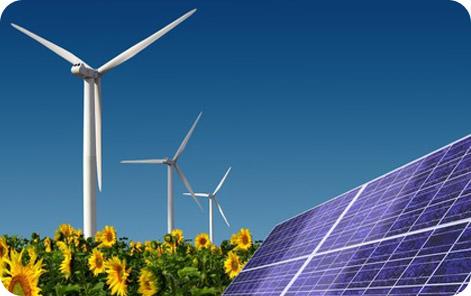 Renewable energy is defined as including
the following sources of energy:
Renewable energy is defined as including
the following sources of energy:
- Wind
- Geothermal
- Biomass
- Small Hydro-electric
- Solar Thermal PV (photovoltaic)
Low-carbon renewable energy replaces conventional fossil fuels in
three main areas:
- Power Generation
- Hot water/ Space Heating
- Transportation Fuels
The California Energy Commission recommends various
strategies be employed to expand the renewable energy mix in
order to diversify the energy supply as well as decrease
greenhouse gas emissions. Some strategies include increased
production of ethanol from cellulosic biomass material
such as municipal, agricultural, and forestry wastes.
Solar offers clean, renewable and reliable energy sources at
different scales, from residential to industrial. Distributed
generation, such as co-generation facilities, also offers an
alternative to central station fossil-fueled generation, through
combining heat and power in facilities that recycle waste energy.
Wind energy is playing an increasingly large role in California’s
electricity portfolio. Additionally, hundreds of homes and farms
are using smaller wind turbines to produce electricity.
Solar
Solar energy is the radiant light and heat from the sun. The
technologies used to harness solar energy include solar heating,
solar photovoltaics, solar thermal electricity and solar
architecture. Solar energy is considered to be inexhaustible and
a clean renewable energy source.
Solar energy technologies are broadly characterized as either
passive solar or active solar depending on the way they capture,
convert and distribute solar energy. Active solar includes the
use of photovoltaic (PV)
panels and solar thermal collectors to harness the energy.
Passive solar includes building orientation, building materials
with favorable thermal mass or light dispersing properties, and
designing spaces that naturally circulate air.
Geothermal
Geothermal power is the conversion of geothermal energy into
electricity and heating, through the use of technologies such as
dry steam power plants, flash steam power
plants and binary
cycle power plants.
Geothermal technologies use wells that tap the difference in
temperature between the core of the planet and its surface. This
thermal energy, or heat, can be used directly to heat homes or
neighborhoods, or can be converted into electricity. Geothermal
energy is considered to be inexhaustible, although not broadly
located, and a clean renewable energy source.
Wind
Wind power is the conversion of wind energy into electrical or
mechanical energy, through the use of wind turbines, windmills,
or windpumps. Each of these can be individual
installations, or collectivized into large
installations. Large wind farms may consist of several
hundred wind turbines which are connected to the electric
power transmission network. Wind power, as an
alternative to fossil fuels, is considered to be inexhaustible,
although sporadic, and a clean renewable energy source.
The USGS has created this publicly available national dataset and
interactive mapping application of wind turbines.
Hydro-Electric
Hydro energy, or hydropower, is power derived from the energy of
falling water. Hydropower can produce electricity or can power
various mechanical devices, such as watermills and sawmills. One
common method of using water energy is a hydroelectric dam, where
water run electric generators. Power can also be generated from
the energy of tidal forces or wave power, which uses the energy
created by moving waves. Hydro energy is considered to be
inexhaustible and a clean renewable energy source.
Additional Resources
As part of the December 11, 2013, Business Meeting, the Energy
Commission adopted the New Solar Homes Partnership Guidebook,
Seventh Edition (NSHP Guidebook). The NSHP Guidebook describes
the requirements for participating in NSHP and receiving
incentives for installing eligible solar energy systems on new
residential construction located in specified investor-owned
utility territories.
The effective date of the NSHP Guidebook, Seventh Edition is
January 1, 2014.

